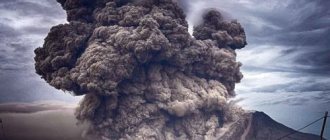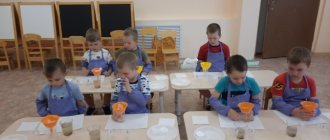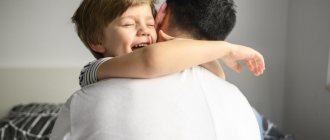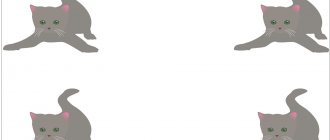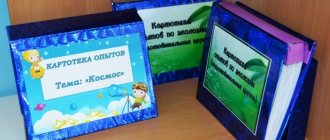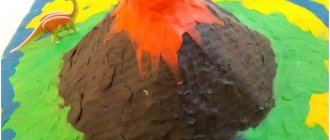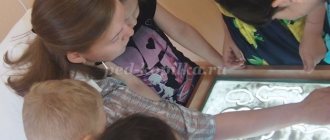Conversation “What do we know about stones”
Municipal state preschool educational institution
Kindergarten No. 9 in Karabash"
Project
Cognitive and research activities
"Stone Tale"
For older children
Prepared by: Dimitrina Irina Vyacheslavovna,
teacher
2017
Type of project : informational-cognitive-research, group
Duration: medium term -1 month
Project participants : children of the senior group, parents of students, teachers.
Project structure.
Problem : Traditionally, more attention is paid to plants and animals, and little consideration is given to inanimate objects. Therefore, children do not have enough knowledge about the rocks and minerals around us. Relevance: Living in a country rich in minerals, children have no knowledge about the stones and minerals around us. Introducing children to a variety of stones helps them become more familiar with the nature of Russia. Direct communication with stones has a great influence on the formation of moral feelings in a child, contributes to the formation of an active vocabulary, develops imagination, and promotes the harmonious development of personality. Involving children in research activities is a means of developing their curiosity, interest and respect for natural resources. Project goal: Creating conditions for the development of cognitive and research abilities of students. Project objectives: Educational: 1. To introduce children to the natural material - stone. 2. Develop the ability to determine the properties and qualities of a stone. 3. Clarify children’s knowledge about the use of stone in human life. Developmental: 1. To develop children's cognitive interest, attention, speech, imagination. 2. Encourage children to be active and experimental. Educational: 1. Develop initial forms of cooperation between children and each other. 2. To cultivate sensitivity, kindness, and responsiveness in children.
Expected result: For children: Children will acquire knowledge about the properties of stones, the features of their appearance, as well as the benefits of stones in nature and human life. Formation of cognitive interest in the world around us, skills of observation and experimentation. Children naturally carry out scientific and creative tasks (experiments, observations, modeling from salt dough).
For the teacher: Introduction of innovative technologies, modern forms and new methods of work. Increasing the theoretical level and professionalism of teachers in the organization of children's search and research activities. Improving the subject-development environment. For parents: Creating favorable conditions for the development of the child in the family, taking into account the experience gained in kindergarten; Development of joint creativity of parents and children; The emergence of a desire among parents to take an interest in the life of the group and actively participate in it;
| Stages | |
| Preparatory stage Goal: Increasing the level of knowledge about natural stones and their properties. | |
| · Drawing up a project plan. · Studying materials on the topic on various sites · Selection of literature · Introducing parents to the project. · Creation of a developing environment (thematic album “Stones”, collection of stones) · Replenishment of the experimentation corner · Selection and production of visual demonstration material (diagrams, tables) · Diagnostics of children | |
| Main stage Goal: Formation of children's knowledge about stones and their properties through experimental and research activities. | |
| Integration of education regions | Activities |
| Cognition: Experimental activities | -Conversations “What do we know about stones” “Does a person need a stone?” “Precious stones” -Use of stones as a counting material in mathematics (what is more, what is less; by how much; size: large, small, large, small, etc.) -Experimental activities to introduce children to the world of stones: “Amazing stones” , “Simple and valuable stones in nature”, “Stones given by the sea”, Game experiments: “Which stone is heavier?” “Pyramid of stones” “Sinking or not sinking?” Experiments: -Can a stone make sounds? -Do stones change color? -Drawing stones. -Durable pebble. -Why are stones multi-colored? -How does water wear away stones? |
| Social and communicative development | -D\and with stones for the development of sensory abilities, fine motor skills: “Find the same stone”, “Find out by touch”; — Puzzles: “What is made of what”; — Role-playing games: “Geologists” (introduction to the profession of “geologist”) — Board games: “The fourth odd one,” “Which is what?”, “Find a pair,” “Collect a picture,” —“Place it in order” — Washing stones. |
| Speech development: | P.P. Bazhov “Silver Hoof”, “Malachite Box”; I.N. Ryzhov “What the Stones Whispered About”; N. A. Ryzhova “What is under our feet.” Reading poems, fairy tales about stones. |
| Physical development: | Walking along a stone path; Physical exercises "Mountain and pebbles". P\i "Destruction of the mountain" |
| Artistic and aesthetic development: | Creative workshop (stone painting). Modeling stones from plasticine Drawing with crayons on a board or paper Laying out drawings from stones |
| Final stage Goal: monitoring the knowledge gained on the proposed topic. | |
| Recommendation for parents: “Tell your children about minerals” Conducting a mini-quiz with children “What do we know about stones” Mini-survey of parents on the material covered in the project. | |
Diagnostics of children's knowledge on the topic “Stones” was carried out at the beginning of the project and after its completion. Questions were asked to the children individually in a relaxed atmosphere in the morning and evening, after a short preliminary conversation. Children were asked to answer the following questions:
· Where in nature can we see stones?
· Why do people need stones?
· What types of stones are there?
· What are the people who search for and examine stones called?
· What is stone made of?
The diagnostic results showed that at the initial stage of work, 3 children (12%) showed a relatively high level, and after completion of the project, 11 children (44%) answered the same questions correctly.
Bibliography
· Bondarenko T.M. Ecological activity for children 6-7 years old. Practical guide for educators and methodologists of preschool educational institutions. — Voronezh: TC “Teacher” 2004;
· Volchkova V.N., Stepanova N.V. Lesson notes for the senior group of kindergarten. Cognitive development. Educational and methodological manual for educators and methodologists of preschool educational institutions. – Voronezh: TC “Teacher”, 2004;
· Goncharova E.V., Moiseeva L.V. Technology of environmental education of children in the preschool group of preschool educational institutions. - Yekaterinburg: publishing house "Center for Childhood Problems", 2002;
· Dybina O.V., Razmanova N.P., Shchetinina V.V. The unknown is nearby: Entertaining experiences and experiments for preschoolers. – M.: TC Sfera, 2005;
· Ivanova A.I. Methodology for organizing environmental observations and experiments in kindergarten. Benefit for preschool employees. - M.: TC Sfera, 2003;
· Ivanova A.I. Natural scientific observations and experiments in kindergarten (people). - M.: Sfera, 2005;
· Comprehensive lesson on ecology for older preschoolers. Methodical manual, ed. S.N. Nikolaeva. – M. Pedagogical Society of Russia, 2005;
· Nikolaeva S.N. Introducing preschoolers to inanimate nature. Nature management in kindergarten. Toolkit. – Pedagogical Society of Russia, 2005;
· Organization of experimental activities of preschool children: Methodical editions / Ed. Prokhorova L.N. – 2nd ed., rev. and additional – M.: ARKTI, 2004;
ANNEX 1
Conversation “What do we know about stones”
Guess the riddle: It burns with fire in mom’s earrings. It lies useless in the dust on the road. It changes shape, it changes color, and is good for a thousand years in construction. It can be small - lie in the palm of your hand. Heavy, large - cannot be lifted by one. Who, children, guessed my riddle? Who recognized this object by signs? V. Miryasova Let’s talk about stones. The children sit at the tables. On them are trays (one for two children) with stones, a wooden block, a vessel with water, and napkins. Teacher. Now I'll turn on the music. You will close your eyes, listen carefully and imagine the picture that the music will tell you (Children listen). What did you hear? And you? What images flashed before your eyes? (Answers) Let's listen to the music again. Do you hear how the sea roars, how the waves, rushing onto the shore, roll stones from place to place, how they knock against each other? How many of you have been to the sea? What did you see there? Children. There are a lot of pebbles on the seashore, the sea is beautiful... Teacher. Find sea stones on the tray and place them on a napkin in front of you. Look at the stones and say: what are they? What shape, color, what surface do they have, what edges? (Beautiful, different colors) Why are they like this? Yes, the sea waves made them so smooth. In sea water, stones beat against each other, the water grinds their edges, and they become smooth, smooth - without a single corner. Now find river pebbles and place them next to the sea ones. Touch them. What can you say about river stones? What are they? (Rough, uneven, different shapes, with sharp corners). So how do sea stones differ from river stones? (Answers) Take the stone in your hand and squeeze it tightly. Has he changed his form? That's right, no. Why? (It's hard). Do you think it is harder than wood? Let's check. I'll take a hammer, a nail and a block of wood. And I'll try to drive a nail into a tree. What happened? (The nail went into the wood.) Now I'll try to drive a nail into a stone. (He scores - it doesn’t work, invites two or three children to try to do the same). Let me try again. What will happen? (The nail bends, but does not drive in.) Well, were we able to hammer the nail into the stone? (Answers) What conclusion can be drawn? Children. Stone is harder than wood. Teacher. How will stone and wood behave in water? There is a vessel with water in front of you, try to lower the tree into the water. What will happen to him? (The tree floats). Let's carefully lower the stone into the water. What happened to him? (The stone sinks). Why? (It is heavier than water). Why does the tree float? (It is lighter than water.) Pay attention to the stone that lies in the water. Get it out. What is he like? (Wet). Compare it with a stone lying on a napkin. What is the difference? (In color. Wet stone is darker.) Where can you see the stones? That's right, in the river, in the sea, on the road.
Abstract "Stones and their properties"
MADOU "Strelsky kindergarten "Fairy Tale"
LESSON SUMMARY
Topic: “Stones and their properties”
2018
Integration of educational areas:
- Social and communicative development
- Cognitive development
- Speech development
- Physical development
- Artistic and aesthetic development
Target:
familiarization with the properties of stone.
Tasks:
- Teaches children to recognize the properties of matter by touch: hardness, softness, buoyancy;
- Teaches to compare and distinguish substances according to their state;
- Develop the ability to independently build a hypothesis before starting an experiment and compare it with the result;
- Cultivate interest in the gifts of the Earth's storehouses.
Material and equipment:
a letter, a box with decorations and various stones, a model of a mountain, aprons, rope, colored pencils, a table - “Algorithm for describing a stone” for each child, magnifying glasses, glasses of water, illustrations of various houses, beautiful buildings, palaces made of stone.
Preliminary work:
collecting various stones for the collection, reading fairy tales by P. Bazhov, conversations on the content.
There is a knock on the door, a gnome comes to visit, brings a box and a letter from the gnome brothers. Reads the letter.
“Hello, dear friends! The dwarf brothers are writing to you from a small mountain village. A mountain river flows next to us. Everything is so unusual in the mountains: clouds and birds appear below you, and not above your head. But the most precious thing for us is underground. We gnomes are constantly looking for gemstones and making jewelry. We send you some as a gift. Stones are so different! A stone can tell a lot to any person, especially a gnome. You just need to be able to reveal its secrets. In the mountains we often meet people who are looking for stones - geologists. They believe that any stones are interesting. Maybe they're right. To make the soup salty, you need salt, and salt is also a stone. Each pebble has its own history, its own interesting properties. We, gnomes, invite you to the mountains, where we have hidden many different stones. Let each of you find your stone and find out its secret. Good luck to you!
Dwarfs are guardians of stones"
The teacher and the children examine the contents of the gnomes' box. They are talking.
—What are these items needed for? (for decoration, for beauty)
-What are they made of? (from different stones)
-Are they similar to the stones that we find on the street? (No)
— Could they be relatives?
-Why are stones needed in nature?
-Where can you find stones?
The teacher invites the children to become geologists and go to the mountains in search of stones that the gnomes hid.
Children head to a model of a mountain where various stones are hidden and look for them. Having found it, they examine it.
— Did you find different or identical stones? (different)
— Are your stones an object of nature or not? Why do you think so?
— Are stones living or inanimate nature?
The children put the stones in their backpacks and go to the laboratory. On the way they encounter obstacles: jump over a stream, walk over pebbles, holding on to a rope . (Physical education minute)
In the laboratory, children become scientists and examine rocks using a magnifying glass and various materials. The research results are entered into a table. The teacher directs the children's research activities.
Experience No. 1.
- Look at the stones through a magnifying glass and mark in the table what color your stone is. (Children make a sketch with colored pencils)
Experience No. 2.
- Touch the stone. How does it feel: smooth or rough? Enter the result in the table.
Experience No. 3.
— What else can be found on the stone? (chips, cracks, drawings, patterns) If they exist, put (+), if not (-). Scratch your stone with your fingernail. If there is a scratch, your stone is soft, put the letter “M”; if there is no scratch, your stone is hard, put the letter “T”.
Experience No. 4.
— Place the stone in the water. What happened? (drowned) mark the result in the table.
— Have all the stones sunk? (expanded clay did not sink) Has the stone changed color?
Experience No. 5.
—Put the stone against your cheek. What is it like: warm or cold? Hold the stone in your hand and then press it against your cheek again. Have your feelings changed? Has it become warmer?
After finishing the experiment, children use a table to talk about the properties of their stone.
Next, children look at illustrations of various buildings and crafts made of stone: houses, palaces, boxes, figurines, souvenirs.
GCD theme: “Collection of stones”
Summary of direct educational activities
Topic: “Collection of stones”
Participants:
senior preschool age.
Kind of activity:
communicative, productive, motor, cognitive and research.
Target:
expand children's understanding of the properties of stones, teach them to classify stones by their appearance.
Tasks
:
Educational:
To develop cognitive activity, observation, the ability to analyze, compare, and generalize through collecting a collection and describing it.
Continue to introduce children to the variety of stones, their properties,
features.
To develop the ability to classify stones according to different characteristics.
Educational:
Develop children's speech and thinking.
Enrich children's vocabulary, introduce words into the active dictionary: inexpressive, rough, smooth, uneven.
Educational:
Foster a caring attitude towards inanimate nature.
Preliminary work:
Consideration of encyclopedias about minerals of the native Ural region and Russia. Study of some minerals, their properties, applications; reading P. Bazhov’s fairy tales “Zhivinka in Action”, “Stone Flower”; collecting a collection of stones with children; working with a globe, map; study of some natural areas of Russia; study of the surface of the earth's crust;
Demonstration material and equipment:
Stones on plates; plasticine; glasses of water; spoons, boxes; music recording; illustrations of stone buildings; exhibition of precious stones and jewelry.
Amos used:
. "Box of sensations"
.
Progress of direct educational activities:
1. Organizational point:
(Children enter the group and greet the guests)
2. Introductory part:
Educator: Guys, look at the trays and tell me what they are? (stones)
-Where can you meet them? (everywhere)
— The planet we live on has stone clothing. Where clothing is visible, there are many stones on the surface, and stone mountains rise. They are very tall and have many protrusions. There are very few plants on the mountains. And the highest mountains are covered with snow, but due to the fact that it often rains and winds blow, the mountains are gradually destroyed, stones break off from them, and the wind carries them everywhere. Therefore, stones can be found everywhere.
3. AMO:
“Box of Feelings”
Children approach the demonstration table. On it lies a box of sensations, inside of which lies one large stone. Children take turns approaching the box. They stick their hands in from both sides and feel the object. They conclude: what lies inside the box? - Stone.
4. Demonstration of working methods and explanation:
Educator: - And now we will do experiments. It turns out that stones have many different properties. (Children go to the tables)
Experience No. 1. The most beautiful and the ugliest.
- Guys, look carefully at the pebbles. (Children examine stones with a magnifying glass)
- Look how beautiful they all are, but among them you need to choose the most beautiful one and show me.
- Why did he seem the most beautiful? (Children's answers)
- So, what kind of stones can there be?
Experience No. 2. Color.
— Guys, what color are your stones? (Children's answers)
- So, how else do the stones differ from each other?
Experience No. 3. The biggest and the smallest.
-Guys, now show me the largest and smallest stone. (Children show stones)
“It turns out that stones can be large and small, that is, they differ in size.
Experiment No. 4. The roughest and smoothest.
— Stones can be rough or smooth. Let's choose a smooth stone. It's nice to touch it with your hands. It is so smooth that it can slip out of your hands; it is called a naked. (Children choose a smooth stone and show it to the teacher)
“Now let’s choose a rough, angular pebble.” Show it. (Children show a smooth stone)
— Water moves the stones, hits them against each other, they rub against the sand and the sharp corners gradually disappear, the stones become smooth, round
- Guys, what other types of stones are there?
5. Physical education moment. Game "Mountain and Pebbles"
(Children stand huddled close to each other - this is a mountain. Music plays.)
Teacher's voice:
“Once upon a time there was a big, big mountain. She considered herself the strongest, but the wind and water said that they were stronger. Years passed. Water rained down on the mountain, and the wind carried small pebbles and grains of sand from the surface of the mountain. Just like that, one pebble rolled, then another, a third, a fourth... The mountain began to shrink. In the end she became completely invisible. So the wind and water defeated the mountain. (Children run away from the mountain one by one)
Educator:
Having rested, we continue a little further.
Experience No. 5. The hardest or softest.
- Guys, take a pebble in one hand and plasticine in the other. Let's squeeze both palms. Let's see what happened to the stone, and what happened to the plasticine? (Children's answers)
- Why?
- So what kind of stones are they?)
Experience No. 6. The heaviest and lightest.
- Now, put a pebble in the water and see what happens. Did the pebble drown? Why?
- Guys, now let’s take expanded clay and put it in the water. What do we see? (He didn't drown.) There are a lot of air bubbles in the expanded clay, so it doesn't sink. This means that stones can sink or they can float.
Experience No. 7. Color.
- Guys, let’s put a pebble in the water and take it out with a spoon. Has the color changed? Stones in the water change color and become darker.
Experience No. 8. Sound.
- Let's hit the stones against each other. What we hear. You see, stones can still create sound. Let's try to make a musical instrument. Let's pour some small pebbles into a plastic box. Let's close it and make some noise. What does it look like?
Experience No. 9. Drawing.
— Guys, let’s learn about one more property of the stone. To do this, Roma will go up to the board and try to draw with a stone. What do we see? Do you know what this stone is called? What can be concluded?
6. Summary:
Educator:
— Today we learned a lot of new and interesting things about stones. Let's remember their properties. (Children's answers)
- Guys, do you think we need stones? (Children's answers).
— Stones are a very durable building material. See what you can build with stones. (Children look at buildings made of stones) There are also precious stones from which jewelers make jewelry. (Children look at the exhibition of jewelry made from precious stones and share their impressions).
Project: Creation of a mini-museum “The Mysterious World of Stone”
Municipal preschool educational institution
Novoulyanovsk general developmental kindergarten "ABVGDeyka"
Project: Creation of a mini-museum “The Mysterious World of Stone”
Kazantseva Tatyana Aleksandrovna
MDOU Kindergarten "ABVGDeyka", teacher
Novoulyanovsk, 2015
Project: Creation of a mini-museum “The Mysterious World of Stone”.
Project type:
group, information-cognitive-research.
Form of presentation
: design of a mini-museum of stone, excursion to the museum (conducted by children of the older group)
Direction
- natural science, with elements of local history.
Project duration:
long-term.
Dates and place of the project:
September - March, MDOU D/S "ABVGDeyka"
Project participants:
Children of the older group (5-6 years old), parents of students, group teachers.
Relevance of the project.
Even in preschool childhood, a child must learn to navigate nature, the phenomena of the surrounding reality, social life and his own life. In order to form in children a holistic understanding of the world around them, more attention should be paid to a comprehensive study of living and inanimate nature, the ecosystem of the region, and the country as a whole. Let us carefully look under our feet, lift up and examine one of the mysteries of nature - stone. Few people thought that the earth consists of only two components, stone and water. Since ancient times, the connection between man and nature and stone has been known. Stones and minerals are amazing gifts of nature. People treated the mysterious and mysterious powers of stones with great respect.
Introducing children to the minerals of the Ulyanovsk region, mined in the quarries of the city of Novoulyanovsk, simply with stones found on the banks of our Volga River, helps to broaden the children's horizons, the ability to establish connections between the properties and characteristics of various materials, the ability to identify the materials from which objects are made, familiarity with professions of people. Involving children in experimental and research activities is a means of developing their curiosity and interest in natural resources.
The knowledge acquired by children during the project becomes the property of their personal experience. They were obtained in response to questions posed by the children themselves during the project activities. The best discovery is the one the child made himself.
Objective of the project:
creating conditions for the development of cognitive and research abilities of pupils, for the formation of a holistic worldview of a preschool child through experimentation, the result is the creation of a mini-museum “The Mysterious World of Stone”.
Project objectives:
To develop research skills aimed at understanding the world around us; Develop the ability to identify the materials from which stone products are made, examine stones, name their properties and features, classify stones according to their distinctive features.
To develop interest in objects of inanimate nature and in experimental activities with them.
Enrich the vocabulary of preschoolers, activate their thinking abilities.
To form moral and patriotic feelings for the native land, pride in the cultural and historical heritage.
Develop curiosity, interest and caring attitude towards the diverse natural resources of the Ulyanovsk region and hometown.
Project content:
The project to create a mini-museum “The Mysterious World of Stones” introduces children of senior preschool age to the variety and properties of different stones, their features, meaning and their varied uses by humans. Children develop interest in objects of inanimate nature, and form moral and patriotic feelings towards their small Motherland.
Project progress
| Program section | Types of children's activities |
| Play activity Cognitive development Research activities Speech development Productive activity Working with parents | Didactic games with stones to develop sensory abilities and fine motor skills: “Pick up the same stone”, “Find out by touch”, “Mosaic of stones”, “Stone labyrinth”, “Lay out the stones according to the pattern”. Board-printed games: “What is made of what”, “Checkers”, “Minerals”, “Pick up a pebble” (fix the names of natural and artificial stones). Role-playing games: “We are geologists”, “In the cave of the mountain king”, “In the jewelry workshop”, “We are miners”. Construction games: “In the Novoulyanovsky quarry”, "Mining". Outdoor games: “Take a stone”, “We are climbers”, “King of the mountain”, “Find your stone”. A series of thematic lessons on the topic: “Stones are interesting”, “What are minerals and how are they mined?”, “Mineral resources of the Ulyanovsk region”, “Meet the ammonites”, “Simbircite is a stone that brings good luck”, “ Stones that write", "Volcanic stones", "Stones born of the sea". “The significance of stones and their benefits for people,” “Our cement plant.” Production and design of expositions of the mini-museum “The Mysterious World of Stone”. Getting to know the parents' professions: bricklayer, excavator operator in a quarry (invited to perform in the group). Creation of the albums “The World of Stones”, “Stones from Which They Build”, “Stones That Heal” Collecting a collection of stones. Viewing collections of stones. Experiments with stones: Salt (salt crystals were grown, salt water prevents an object from drowning), Water and stone (how water destroys stones), The heaviest and lightest (comparing stones by weight), Is there air in a stone? What is the best stone to draw on asphalt (chalk, coal, graphite)? , “Why do they say - strong as a stone”, “What’s inside the mountain?” Experimental activity: Which stone is best for drawing on asphalt (chalk, coal, graphite)? Examining stones through a magnifying glass - Describe “who sees what” (crystals, cracks, patterns, etc.). Children compose creative stories “Good - bad” - properties of stone (TRIZ), “If I became a stone.” “Guess what stone I found?” -compiling a mini-story describing the found stone. Creation and illustration of the album “Tales of Stones”. Video films and filmstrips: “Malachite Box”, “Stone Flower”, “Silver Hoof”; Reading the book “The Adventures of Melochka” - the author’s book by Romanova V.N.g. Novoulyanovsk; Reading - N.I. Sladkov “Dried Stones”, “Chowder from Stones” - Italian fairy tale; “Bear-Stone” - Japanese fairy tale, E. Karetnikova “Mermaid Stone”, A. Agafonova “The Tale of the Dwarf and the Rainbow Stone” Memorizing children's poems about stones, authors V. Kulaev, E. Shendrik, A. Orlova, S. Ostrovsky. Iso-activity: “Magical transformation of stones” (drawing according to plan), drawing with a pebble on the sand, drawing a plot on stone, drawing with sand, salt, with crayons on the asphalt, with simple pencils. Making a panel and collage of stones. Construction: construction of buildings and crafts from stones: “Palace made of stone”, “Stone castles”, “Naf-Naf House”. Making models: “Volcanoes and mountains”, “Stones that write”, “Stones born of the sea”, “Precious stones”, “Ammonites”, “Simbircites”. Design of the mini-encyclopedia “World of Stones” for preschool children. Making crafts from natural stone “What is what?” Making board games using Tic-Tac-Toe and Tag stones. Exhibition of joint works of parents and children made of stone: “Stone Masterpieces”. Meetings with interesting people. A story about the profession. Excursion to the Volga River. Design of the mini-museum “The Mysterious World of Stones” in the group (active assistance of parents) Presentation of the museum (presented by children). |
Expected Result:
Children have formed ideas about the properties of stones, the features of their appearance, knowledge about the benefits of stones in nature and human life. They have an idea of how stones are mined and how they are used, what minerals Russia, the Ulyanovsk region, and the city of Novoulyanovsk are rich in. Demonstrate cognitive abilities: demonstrate the prerequisites for search activity and intellectual initiative. They translate ideas into creative activities.
Using the results:
The result of this project was the acquisition by children of the skills of a caring, creative attitude towards the world around them, new knowledge, which made it possible to form the prerequisites for educational and research skills in accordance with the main lines of development.
1.Golitsyn M.S. “Treasures of the Earth” I explore the world. M. Publishing house - in AST, 2001.
2. Dybina. O.V. The unknown is nearby: Entertaining experiences and experiments for preschoolers / O.V. Dybina, N.P. Rakhmanova, V.V. Shchetinina. - Moscow. Creative Center, 2004.
3. Dybina. O.V. A child in the world of search / O.V. Dybina.-Moscow. Creative Center 2007
4.Ivanova, A.I. Methodology for organizing environmental observations and experiments in kindergarten / A.I. Ivanova. - Moscow. Sphere shopping center, 2006.
5. Ryzhova N.A. “What is under our feet” (sand, clay, stones) M, 2005.
6. Ryzhova N.A. “Mini Museum in Kindergarten” M, Linka – Press, 2008.
6. Secrets of nature (School of the Seven Dwarfs for classes with children from 5 to 6 years old) - Mozaika Publishing House - Synthesis 2008.
7.Materials of Internet sites.
Experiments with stones senior group (5-6 years old)
Principles of preschool education (FSES DO):
1) full-fledged experience by the child of all stages of childhood (infancy, early and preschool age), enrichment (amplification) of child development;
2) building educational activities based on the individual characteristics of each child, in which the child himself becomes active in choosing the content of his education, becomes a subject of education (hereinafter referred to as individualization of preschool education);
3) assistance and cooperation of children and adults, recognition of the child as a full participant (subject) of educational relations;
4) supporting children’s initiative in various activities;
5) cooperation of the Organization with the family;
6) introducing children to sociocultural norms, traditions of the family, society and state;
7) formation of cognitive interests and cognitive actions of the child in various types of activities;
 age adequacy of preschool education (compliance of conditions, requirements, methods with age and characteristics of activity;
age adequacy of preschool education (compliance of conditions, requirements, methods with age and characteristics of activity;
9) taking into account the ethnocultural situation of children’s development.
Educational and methodological kit:
Federal state educational standard for preschool education. / Ministry of Education and Science of the Russian Federation, order No. 1155 of October 17, 2013.
Approximate basic educational program for preschool education P 56 “Paths” / ed. V.T. Kudryavtseva. M.: Ventana-Graf, 2014
Environmental education of preschool children. Experiments with water [Electronic resource]: For preschoolers. — 2015.
Principles of preschool education (FSES):
A child’s full experience of all stages of childhood, enrichment of all stages of child development; building educational activities based on the individual characteristics of each child; recognition of the child as a full participant in educational relations; formation of the child’s cognitive actions; age adequacy of preschool education.
Principles of education:
Creating a positive emotional uplift, developing a personal style of relationships with peers and teachers.
Principles of training:
the principle of visibility, the principle of accessibility, the principle of activity (include children in active activities).
Education methods:
conversation, encouragement.
Teaching methods:
conversation, demonstration, stimulation with entertaining content
Speech development methods:
Verbal
(
conversation), practical (exercise)
Equipment: Water container, stones, napkins, spoons, cups with chopsticks 6 cm long
| Stage, tasks | Methods | Activities of a teacher | Children's activities | Planned result |
